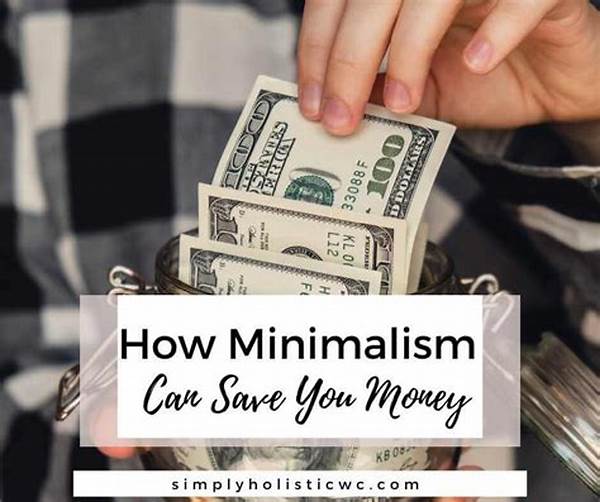Minimalism has become more than just a trendy lifestyle choice; it’s a smart financial decision. Imagine living in a home where everything you own serves a purpose and brings you joy. Not only is your space clearer, but so is your mind—and your bank account. The essence of minimalist living revolves around the idea of decluttering both physically and financially. By shifting towards this lifestyle, you embrace intentional living that prioritizes needs over wants, ultimately cutting back on unnecessary expenses.
Read More : Best Minimalist Home Trends Loved By Millennials
The pathway to financial freedom is illuminated by adopting minimalist principles. Evidence suggests that those who practice minimalist living often report significant savings in their finances, indicating that gentler living can facilitate richer pockets. For instance, when faced with the urgent need to decide what truly holds value, individuals often spend less on impulse buys and unnecessary items. Instead, such decisions lead to more substantial financial goals like savings, investments, or luxurious experiences that create lasting memories. Consequently, minimalist living isn’t about depriving oneself, but rather about making informed choices that yield long-term benefits.
Moreover, minimalist living reshapes your relationship with time and money—two of life’s most precious resources. Freeing yourself from the binds of material possessions means less time spent on maintenance, organization, and possibly even working extra hours to afford a lifestyle that isn’t gratifying. This extra time can be reallocated to nurturing personal growth, family, and hobbies, which not only enhances your quality of life but also encourages mindful, cost-effective living. Minimalism as a lifestyle aligns perfectly with the notion of how minimalist living saves you money long term by reducing stress and financial burdens.
—
Financial Benefits of Minimalist Living
Shifting gears into a minimalist lifestyle invites a refreshing perspective on how to allocate your financial resources effectively. As you transition into buying less, you’ll notice a drop in expenses solely due to reduced consumption. This naturally leads to an accumulation of savings over time, allowing for greater financial security. Imagine planning a dream vacation or investing in your retirement fund, all made possible by the funds saved from unnecessary purchases. Embracing fewer but more meaningful possessions turns every dollar spent into an investment towards a more abundant future.
—
Embarking on a minimalist journey redefines how you interact with both money and the world around you. At its core, minimalism challenges the traditional consumerist mentality, advocating for a simpler, yet more enriched life. With minimalism, less truly becomes more, as you prioritize quality over quantity. This philosophy not only benefits your mental wellbeing but also ensures your financial plan is more strategic and aligned with your true desires.
By setting boundaries and saying no to excess, you can focus on cultivating relationships and experiences that enrich your life without causing financial strain. Imagine no longer needing to chase every trendy gadget or newest fashion—it’s liberating. How minimalist living saves you money long term is rooted in the choice to value experiences over material possessions, ensuring every expense has a purpose and brings genuine satisfaction.
Minimalism also encourages smarter financial habits such as budgeting, investing, and planning for the future. With the clutter out of the equation, your financial roadmap becomes clear, and pushing towards larger financial goals becomes more achievable. As minimalist living cleanses your space, it simultaneously cleanses your financial behavior, promoting savings, reducing debt, and optimizing spending.
However, transitioning isn’t always smooth sailing; it requires conviction and a continual commitment to maintaining a minimal lifestyle. It involves regular evaluations of needs versus wants and the courage to let go of what doesn’t serve your vision for life. Yet the rewards are immense, as time and money are redirected towards meaningful pursuits, creating a life centered around intentional abundance rather than mindless accumulation.
—
Practical Examples of Minimalism in Action
—
Goals of Embracing Minimalism
The shift towards a minimalist lifestyle is motivated by a desire for simplicity and clarity. Your goal isn’t merely to save money but to cultivate a life brimming with fulfillment that doesn’t rely on accumulating material wealth. Align your lifestyle with sustaining your well-being, prioritizing emotional and physical health over possessions. By engaging in minimalism, you strive for a balanced existence, where financial and emotional clarity lead the way.
It is also about breaking free from the chains of consumerism. Society often teaches us to associate happiness with the acquisition of goods. Embracing minimalism refutes this notion by proving that contentment does not stem from possessions but from purpose and mindful choices. Transitioning towards a minimalist lifestyle is an empowering journey towards financial independence, and how minimalist living saves you money long term is a steady path to achieving it.
Finally, adopting minimalism aims to create a positive impact not only within your personal sphere but also for the environment and community. The effect of consuming less extends beyond your wallet. Reducing unnecessary consumption contributes to a healthier planet, promoting sustainability and a greater appreciation for all that life offers.
—
Breaking Down the Minimalist Money Saver
Embarking on a minimalist lifestyle can be rewarding, both financially and emotionally. Here’s a rundown of how adopting minimalism can impact your finance and life.
Revelation of True Necessities
Determining what truly matters is the essence of a minimalist lifestyle. By focusing on needs rather than wants, you streamline your expenses. This approach allows you to only purchase items that align with your essential needs, avoiding unnecessary expenditures and significantly reducing impulse spending. The profound understanding of how minimalist living saves you money long term begins with recognizing your necessities.
Time as a Financial Resource
In the realm of minimalism, time is just as valuable as money. By owning less and having fewer commitments tied to material items, more time opens up for pursuits that truly matter—be it personal relationships or profitable ventures. Thus, minimalist living packages upside savings through both time and money.
Living minimally encourages cost-effective creativity—finding joy in simple, inexpensive pleasures and experiences. Ultimately, minimalism isn’t about limiting life; it’s about freeing yourself to build a lifestyle abundant with genuine value, demonstrating once again how minimalist living saves you money long term.


